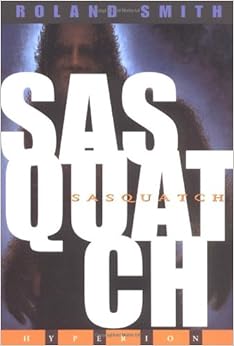What if Sasquatch were real? What would we do if we did discover Sasquatch? What would Sasquatch do? These are all questions at the heart of Roland Smith's young adult novel, Sasquatch, and he does an interesting job in answering them. The story has enough maturity to make it believable, while still making use of enough young adult tropes to keep teen readers interested. There are elements of mystery as new characters are introduced and as the possibility of meeting Sasquatch nears. Smith wonders whether Sasquatch might be just as compassionate as human beings are capable of, and that makes for a much more compelling read than you might imagine.
Dylan Hickock's father loves to tinker with things. He's the kind of person who will devote all of his resources to solving a problem. One day when he returns from a hunting trip, Dylan realizes a new problem has arisen. Yet this one his father keeps to himself for a while, in order to keep his wife's mind at ease. She is planning to go to Egypt for several months to complete her college degree. This leaves Dylan alone with his father's new obsession, and Dylan, of course, becomes involved as well.
This obsession revolves around the existence of Bigfoot, or Sasquatch. Dylan's father claims he saw Sasquatch while on that hunting trip, and he takes Dylan to a secret Bigfoot meeting where a man shows photographs of who he claims is Bigfoot racing up a mountain carrying a deer carcass. A group of men want to investigate this area, around Mount St. Helens, and seek out Bigfoot. Here's where the trouble begins. There are four groups of thought regarding what to do with Bigfoot once he's found: 1) tranquilize him and study him; 2) kill him; 3) capture him at any cost (dead or alive); or 4) leave him alone. The first three options seek to expose Sasquatch to the public. The idea is that he can be better protected if his existence is made known. However, to kill a Sasquatch means to kill what is likely an endangered species, and it also means ending the life of a sentient being.
Dylan's father joins the expedition as a saboteur, and he is helped by Buckley Johnson, a mysterious man with a bad hip who would rather see Sasquatch left alone. It seems that Buck knows much more about Sasquatch than he lets on. The expedition team to hunt Sasquatch convenes at Dylan's house, where Dylan meets Dr. Flagg, the leader of the group. Dr. Flagg's philosophy is to capture Sasquatch at any cost, though he seems to lean more towards killing one. That's why the team has brought in Kurt Skipp, a skilled hunter and a man of few words. Dylan knows Skipp is trouble when he first sees him slice an apple into four pieces with the mere flick of a wrist.
The story does move at a moderate pace, a tad slow, and perhaps without as much action as one might expect from the title. All of the action comes right at the end. Smith seems more interested in the possibility that Sasquatch exists, and how people will react to discovering it. I think it's a small group of people who believe Sasquatch exists, or who are even interested in its existence, but there is always somebody claiming to have some blurry photo of the beast and there is always some new TV show set out to find one. The evidence suggests Sasquatch doesn't exist, but Sasquatch is a mythical being that can't be killed. The world is a large and mysterious place. Mankind has seen a lot of it, but not all of it. The ocean harbors all sorts of unknown beings, but on the land, the possibilities of discovering a new creature the size of Sasquatch are much more limited. It's true, as the book argues, that scientists do continually discover new land species all the time, especially in the rainforest, and that's what keeps the hope of Sasquatch's existence alive.
Smith approaches the topic of Sasquatch with a lot more compassion than I expected. My expectations based on the cover, and my misconception this was a horror story, led me to believe there would be lots of murders. That's not quite the case. Most of the mystery comes from the human characters, such as Buck and Kurt Skipp and whether Mount St. Helens will erupt during the Sasquatch expedition. Sasquatch, in fact, may be the least dangerous character of the bunch, and in that sense Smith may approach wildlife with a touch of naivete, just as a Disney film sometimes portrays a dangerous animal like a bear as friendly. It's hard to believe that a Sasquatch could be morally cultivated to know right from wrong rather than a being that acts on instinct to protect itself.
Still, Sasquatch could symbolize humanity's desire to tinker with the unknown. It's in our nature to discover new things about the world, as though we're afraid the world would become dull without any new discoveries. But what price do we pay by not leaving things alone? Is that price worth what we gain from the discovery? The novel stops short of answering these questions, and instead wraps up the story with a series of action set pieces. In the search for Sasquatch, it remains just as mystical as before the search. The book ends up being satisfying, but difficult to recommend. Just like many young adult novels, there is a mix of sophistication along with the usual YA tropes, but in both cases there doesn't seem to be enough to fully satisfy either adult or young adult readers.

No comments:
Post a Comment